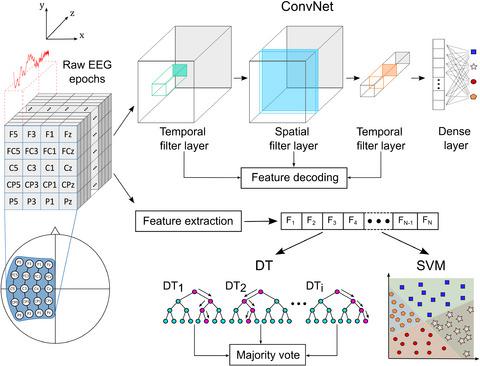当前位置:
X-MOL 学术
›
Eur. J. Neurosci.
›
论文详情
Our official English website, www.x-mol.net, welcomes your
feedback! (Note: you will need to create a separate account there.)
Decoding kinetic features of hand motor preparation from single‐trial EEG using convolutional neural networks
European Journal of Neuroscience ( IF 2.7 ) Pub Date : 2020-08-11 , DOI: 10.1111/ejn.14936 Ramiro Gatti 1, 2 , Yanina Atum 2 , Luciano Schiaffino 2 , Mads Jochumsen 3 , José Biurrun Manresa 1, 2, 4
European Journal of Neuroscience ( IF 2.7 ) Pub Date : 2020-08-11 , DOI: 10.1111/ejn.14936 Ramiro Gatti 1, 2 , Yanina Atum 2 , Luciano Schiaffino 2 , Mads Jochumsen 3 , José Biurrun Manresa 1, 2, 4
Affiliation

|
Building accurate movement decoding models from brain signals is crucial for many biomedical applications. Predicting specific movement features, such as speed and force, before movement execution may provide additional useful information at the expense of increasing the complexity of the decoding problem. Recent attempts to predict movement speed and force from the electroencephalogram (EEG) achieved classification accuracies at or slightly above chance levels, highlighting the need for more accurate prediction strategies. Thus, the aims of this study were to accurately predict hand movement speed and force from single‐trial EEG signals and to decode neurophysiological information of motor preparation from the prediction strategies. To these ends, a decoding model based on convolutional neural networks (ConvNets) was implemented and compared against other state‐of‐the‐art prediction strategies, such as support vector machines and decision trees. ConvNets outperformed the other prediction strategies, achieving an overall accuracy of 84% in the classification of two different levels of speed and force (four‐class classification) from pre‐movement single‐trial EEG (100 ms and up to 1,600 ms prior to movement execution). Furthermore, an analysis of the ConvNet architectures suggests that the network performs a complex spatiotemporal integration of EEG data to optimize classification accuracy. These results show that movement speed and force can be accurately predicted from single‐trial EEG, and that the prediction strategies may provide useful neurophysiological information about motor preparation.
中文翻译:

利用卷积神经网络对单次试验脑电准备手运动的动力学特征进行解码
从大脑信号建立准确的运动解码模型对于许多生物医学应用至关重要。在运动执行之前预测诸如速度和力之类的特定运动特征可能以增加解码问题的复杂性为代价提供附加的有用信息。最近根据脑电图(EEG)预测运动速度和力量的尝试实现了分类精度达到或略高于机会水平的情况,这突出显示了对更准确的预测策略的需求。因此,本研究的目的是根据单次试验脑电图信号准确预测手的运动速度和作用力,并根据预测策略对运动准备的神经生理信息进行解码。为此,实施了基于卷积神经网络(ConvNets)的解码模型,并将其与其他最新的预测策略(例如支持向量机和决策树)进行了比较。ConvNets优于其他预测策略,从运动前的单次EEG(运动前100 ms到运动前1600 ms)对速度和力的两个不同级别进行分类(四类分类)时,总体精度达到84%执行)。此外,对ConvNet架构的分析表明,该网络执行EEG数据的复杂时空集成以优化分类准确性。这些结果表明,可以通过单次EEG准确预测运动速度和作用力,
更新日期:2020-08-11
中文翻译:

利用卷积神经网络对单次试验脑电准备手运动的动力学特征进行解码
从大脑信号建立准确的运动解码模型对于许多生物医学应用至关重要。在运动执行之前预测诸如速度和力之类的特定运动特征可能以增加解码问题的复杂性为代价提供附加的有用信息。最近根据脑电图(EEG)预测运动速度和力量的尝试实现了分类精度达到或略高于机会水平的情况,这突出显示了对更准确的预测策略的需求。因此,本研究的目的是根据单次试验脑电图信号准确预测手的运动速度和作用力,并根据预测策略对运动准备的神经生理信息进行解码。为此,实施了基于卷积神经网络(ConvNets)的解码模型,并将其与其他最新的预测策略(例如支持向量机和决策树)进行了比较。ConvNets优于其他预测策略,从运动前的单次EEG(运动前100 ms到运动前1600 ms)对速度和力的两个不同级别进行分类(四类分类)时,总体精度达到84%执行)。此外,对ConvNet架构的分析表明,该网络执行EEG数据的复杂时空集成以优化分类准确性。这些结果表明,可以通过单次EEG准确预测运动速度和作用力,











































 京公网安备 11010802027423号
京公网安备 11010802027423号